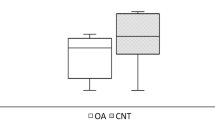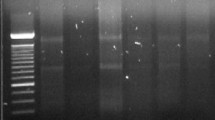Summary
According to the literature subchondral bone plays a significant role in the transmission of load through joints and in the pathogenesis of osteoarthrosis. Therefore the degeneration of the articular cartilage was investigated in the patellae from 30 dissecting-room specimens and of 20 patients, previously submitted to arthroscopy, and subchondral mineralisation of their underlying bone was at the same time assessed by means of CT osteoabsorptiometry. Lateral cartilage lesions were localised over highly mineralised subchondral bone; these appear to be due to long-term stress. They were mainly found in the older specimens and showed a high rate of progression with increasing age. Medially localised cartilage lesions, on the other hand, were situated in a transitional region between moderate and slight subchondral mineralisation; they may be caused by infrequent stress peaks and by shear stress in the articular cartilage, the very medial part of the joint being deprived of mechanical stimulation for much of the time. These lesions were to be found predominantly in the younger specimens and showed little progress with advancing age. Patients with lateral cartilage degeneration exhibited higher, patients with medial chondromalacia patellae lower mineralisation than normals. Their density patterns therefore indicate a different mechanical pathogenesis of the cartilage lesions in the lateral and medial facet. It could be shown that CT osteoabsorptiometry allows an assessment of the mechanical situation, present in individual femoro-patellar joints, and that this situation is highly relevant for the pathogenesis of patellar cartilage degeneration.
Résumé
Selon la littérature, l'os sous-chondral joue un rôle important dans la transmission des forces à travers les articulations et dans la pathogénie de l'arthrose. C'est pourquoi la dégénérescence du cartilage articulaire a été étudiée sur les patellas de 30 sujets anatomiques et de 20 patients venant de subir une arthroscopie et dont la minéralisation sous-chondrale de l'os sous-jacent avait été appréciée au même moment par absorptiométrie osseuse par scanner. Les lésions cartilagineuses latérales étaient situées sur de l'os sous-chondral fortement minéralisé ; elles paraissent êtres dues à des contraintes à long terme. Elles furent principalement trouvées sur les spécimens âgés et montraient un fort taux de progression en fonction du vieillisement. A l'opposé, les lésions cartilagineuses médiales étaient situées dans une région de transition entre des minéralisations modérée et faible ; elles pourraient être dues à des pics de contrainte intermittents et à des contraintes en cisaillement sur le cartilage articulaire, la partie la plus médiale de l'articulation étant privée de stimulations mécaniques la plupart du temps. Ces lésions furent trouvées essentiellement sur les sujets les plus jeunes et montraient peu de progression avec le vieillissement. Les patients présentant une dégénérescence cartilagineuse latérale avaient une minéralisation supérieure à la normale, les patients présentant une chondromalacie médiale avaient une minéralisation plus faible que la normale. La distribution de la densité indique donc un mécanisme pathogénique différent pour les lésions cartilagineuses sur les facettes latérale et médiale. L'absorptiométrie osseuse par scanner permettrait donc d'apprécier la situation mécanique individuelle de chaque articulation fémoropatellaire. Cette situation est fortement corrélée à la pathogénie de la dégénérescence du cartilage patellaire.
Similar content being viewed by others
References
Abernethy PJ, Townsend PR, Rose RM, Radin EL (1978) Is chondromalacia patellae a separate clinical entity? J Bone Joint Surg [Br] 6: 205–210
Alexander Cl (1989) Relationship between the utilisation profile of individual joints and their susceptibility to primary osteoarthrosis. Skeletal Radiol 18: 199–205
Carter DR (1984) Mechanical loading histories and cortical bone remodelling. Calcif Tissue Res 36: 519–524
Dashefsky JH (1987) Arthroscopic measurement of chondromalacia of patella cartilage using a microminiature pressure transducer. Arthroscopy 3: 80–85
Eckstein F, Müller-Gerbl M, Putz R (1992) Distribution of subchondral bone density and cartilage thickness in the human patella. J Anat 180: 425–433
Emery IH, Mechim G (1973) Surface morphology and topography of patellofemoral cartilage fibrillation in Liverpool necropsies. J Anat 116: 103–120
Ficat P, Ficat C, Bailleux A (1975) Syndrome d'hyperpression externe de la rotule (SHPE). Son intérêt pour la connaissance de l'arthrose. Rev Chir Orthop 61: 39–59
Ficat P, Hungerford DS (1977) Disorders of the patellofemoral joint. Masson, Paris
Goodfellow J, Hungerford DS, Woods C (1976) Patello-femoral joint mechanics and pathology. Chondromalacia patellae. J Bone Joint Surg [Br] 58: 291–299
Goodman SB, Lee J, Smith RL, Csongradi JC, Fomasier VL (1991) Mechanical overload of a single compartment induces early degenerative changes in the rabbit knee: a preliminary study. J Invest Surg 4: 161–170
Hehne HJ (1983) Das Patellofemoral gelenk. Enke, Stuttgart
Hvid I, Bentzen SM, Linde F, Mosekilde L, Pongsoipetch B (1989) X-Ray quantitative computed tomography: the relations to physical properties of proximal tibial trabecular bone specimens. J Biomech 22: 837–844
Iwano T, Kurosawa H, Tokuyama H, Hoshikawa Y (1990) Roentgenographic and clinical findings of patellofemoral osteoarthrosis. With special reference to its relationship to femorotibial osteoarthrosis and etiologic factors. Clin Orthop 252: 190–197
Kiviranta I, Jurvelin J, Markku T, Samanen AM, Helminen HJ (1987) Weight bearing controls glycosaminoglycan concentration and articular cartilage thickness in knee joints of young beagle dogs. Arthritis Rheum 30: 801–809
Kummer B (1962) Funktioneller Bau und funktionelle Anpassung des Knochens. Anat Anz 110: 261–293
Maquet PGJ (1976) Biomechanics of the knee. Springer, Berlin Heidelberg New York
Mohr W (1984) Gelenkkrankheiten. Diagnostik und Pathogenese makroskopischer und histologischer Strukturveränderungen. Thieme, Stuttgart New York
Müller-Gerbl M, Putz R, Hodapp N, Schulte E, Wimmer B (1989) Computed tomography osteoabsorptiometry for assessing the density distribution of subchondral bone as a measure of long term mechanical adaptation in individual joints. Skeletal Radiol 18: 507–512
Müller-Gerbl M, Putz R, Kenn R (1992) Demonstration of subchondral bone density patterns by three dimensional CT osteoabsorptiometry as a noninvasive method for in vivo assessment of individual long-term stress in joints. J Bone Min Res 7 [Suppl 2]: 411–418
Müller-Gerbl M, Putz R, Kenn R, Beyer W, Hirschfelder H, Tager KH (1992) Reaction of the subchondral bone to the changes in mechanical stress in the knee joint following osteotomy. Oral paper on the 8th meeting of the European Society of Biomechanics. June 21–24, Rome, Italy, Abstract, J Biomech (in press)
Outerbridge RE (1961) The etiology of chondromalacia patellae. J Bone Joint Surg [Br] 43: 752–757
Pauwels F (1965) Gesammelte Abhandlungen zur funktionellen Anatomie des Bewegungsapparates. Springer, Berlin Heidelberg New York
Pedley RB, Meachim G (1979) Topographical variation in patellar subarticular calcified tissue density. J Anat 128: 737–745
Radin EL, Abernethy PJ, Townsend PM, Rose RM (1978) The role of bone changes in the degeneration of articular cartilage in osteoarthrosis. Acta Orthop Belg 44: 55–63
Radin EL, Burr DB, Caterson B, Fyhrie D, Brown TD, Boyd RD (1991) Mechanical determinants of osteoarthrosis. Semin Arthritis Rheum 21 [Suppl 2]: 12–21
Radin EL, Paul IL (1970) Does cartilage compliance reduce skeletal impact loads? The relative force-attenuating properties of articular cartilage, synovial fluid, periarticular soft tissues and bone. Arthritis Rheum 13: 139–144
Radin EL, Paul IL (1971) The response of joints to impact loading. In vitro wear. Arthritis Rheum 14: 521–530
Radin EL, Paul IL, Lowy M (1970) A comparison of the dynamic force transmitting properties of subchondral bone and articular cartilage. J Bone Joint Surg [Am] 52: 444–456
Radin EL, Paul IL, Rose RM (1972) Role of mechanical factors in the pathogenesis of primary osteoarthrosis. Lancet 1: 519–522
Radin EL, Rose RM (1986) Role of subchondral bone in the initiation and progression of cartilage damage. Clin Orthop 213: 34–40
Thompson RC, Oegema TR, Lewis JL, Wallace L (1991) Osteoarthrotic changes after acute transarticular load. An animal model. J Bone Joint Surg [Am] 73: 990–1001
Townsend PR, Raux P, Rose RM, Miegel RE, Radin EL (1975) The distribution and anisotropy of the stiffness of cancellous bone in the human patella. J Biomech 8: 363–367
Weh L, Luer C (1987) Plica medialis, Palellaform und Chondromalazie Z. Orthopade 125: 54–62
Wiberg G (1941) Roentgenographic and anatomic studies on the femoropatellar joint. With special reference to chondromalacia patellae. Acta Orthop Scand 12: 319–410
Wu DD, Burr DB, Boyd RD, Radin EL (1990) Bone and cartilage changes following experimental varus or valgus tibial angulation. J Orthop Res 8: 572–585
Author information
Authors and Affiliations
Rights and permissions
About this article
Cite this article
Eckstein, F., Putz, R., Müller-Gerbl, M. et al. Cartilage degeneration in the human patellae and its relationship to the mineralisation of the underlying bone: A key to the understanding of chondromalacia patellae and femoropatellar arthrosis?. Surg Radiol Anat 15, 279–286 (1993). https://doi.org/10.1007/BF01627879
Received:
Accepted:
Issue Date:
DOI: https://doi.org/10.1007/BF01627879




